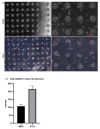A High-Throughput and Uniform Amplification Method for Cell Spheroids
- PMID: 36296003
- PMCID: PMC9607487
- DOI: 10.3390/mi13101645
A High-Throughput and Uniform Amplification Method for Cell Spheroids
Abstract
Cell culture is an important life science technology. Compared with the traditional two-dimensional cell culture, three-dimensional cell culture can simulate the natural environment and structure specificity of cell growth in vivo. As such, it has become a research hotspot. The existing three-dimensional cell culture techniques include the hanging drop method, spinner flask method, etc., making it difficult to ensure uniform morphology of the obtained cell spheroids while performing high-throughput. Here, we report a method for amplifying cell spheroids with the advantages of quickly enlarging the culture scale and obtaining cell spheroids with uniform morphology and a survival rate of over 95%. Technically, it is easy to operate and convenient to change substances. These results indicate that this method has the potential to become a promising approach for cell-cell, cell-stroma, cell-organ mutual interaction research, tissue engineering, and anti-cancer drug screening.
Keywords: 3D cell spheroids; cell culture; drug screening; high-throughput; uniform shape.
Conflict of interest statement
The funders had no role in the design of the study; in the collection, analyses, or interpretation of data; in the writing of the manuscript, or in the decision to publish the results.
Figures






Similar articles
-
Engineering of Primary Pancreatic Islet Cell Spheroids for Three-dimensional Culture or Transplantation: A Methodological Comparative Study.Cell Transplant. 2020 Jan-Dec;29:963689720937292. doi: 10.1177/0963689720937292. Cell Transplant. 2020. PMID: 32749168 Free PMC article.
-
Design and fabrication of a liver-on-a-chip platform for convenient, highly efficient, and safe in situ perfusion culture of 3D hepatic spheroids.Lab Chip. 2018 Aug 21;18(17):2547-2562. doi: 10.1039/c8lc00333e. Lab Chip. 2018. PMID: 30019731
-
Formation of stable small cell number three-dimensional ovarian cancer spheroids using hanging drop arrays for preclinical drug sensitivity assays.Gynecol Oncol. 2015 Jul;138(1):181-9. doi: 10.1016/j.ygyno.2015.04.014. Epub 2015 Apr 22. Gynecol Oncol. 2015. PMID: 25913133 Free PMC article.
-
Cell spheroids as a versatile research platform: formation mechanisms, high throughput production, characterization and applications.Biofabrication. 2021 Apr 8;13(3). doi: 10.1088/1758-5090/abe6f2. Biofabrication. 2021. PMID: 33592595 Review.
-
Recent Advances in Three-Dimensional Multicellular Spheroid Culture and Future Development.Micromachines (Basel). 2021 Jan 18;12(1):96. doi: 10.3390/mi12010096. Micromachines (Basel). 2021. PMID: 33477508 Free PMC article. Review.
References
-
- Muri J., Heer S., Matsushita M., Pohlmeier L., Tortola L., Fuhrer T., Conrad M., Zamboni N., Kisielow J., Kopf M. The Thioredoxin-1 System Is Essential for Fueling DNA Synthesis during T-Cell Metabolic Reprogramming and Proliferation. Nat. Commun. 2018;9:1851. doi: 10.1038/s41467-018-04274-w. - DOI - PMC - PubMed
Grants and funding
- 2020CXGC011304/Shandong Provincial Key Research and Development Project
- Grant No. 32001020/National Natural Science Foundation of China
- No. 82130067/National Natural Science Foundation of China
- ZR2020QB131/Shandong Provincial Natural Science Foundation
- 202004/Qilu University of Technology Foundation/Shandong Academy of Sciences Foundation
LinkOut - more resources
Full Text Sources
Research Materials

